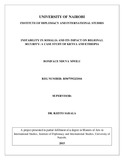| dc.description.abstract | Somalia is one of the nations that has struggled and still does today in order to function well. It is one of these rare places where there is ongoing civil war and it has no central government. The Somali conflict was initially triggered by the dictatorial tendencies of the Mohammed Siad Barre regime in 1991. Subsequently, the conflict has become destructive with negative consequences for the country's moral social fibre, as is manifested by die wanton killing of innocent people, particularly women and children. The overall objective of the study aims to look for linkages between instability in Somalia and its effects on Kenyan and Ethiopian security situation. This study aimed to contribute to scholarly material on effective management of trans-border insecurity in Kenya-Somalia-Ethiopia, which will strengthen intelligence information, security skills enhancements and understanding proper border management key stakeholders.
The study employed Realism theory. A key concept under realism is the international distribution of power referred to as system polarity. The conflict in Somalia has continued for over 20 years, amidst several attempts to mitigate the situation. This has caused Somalia to top Foreign Policy’s Failed State Index from 2008 through 2011. The research adopted Case study design. The study used probability method to come up with the sample population. A population is defined as a complete set of individuals with some common observable characteristics. The study applied both primary and secondary data collection techniques.
The final results were presented in form of narrative, pie chart, bar graph and frequency tables. The analysed data was presented in both qualitative and quantitative manner. The study reveals that clannism was the main cause of Somalia collapse – they reveal that most of the fights have been over resources such as land and water, which were seen as fundamental resources to survive. The study found that exacerbates the conflict over resources is the harsh famines that happen throughout most of Somalia.
The study also concludes that competition over new and growing urban settlements is a more immediate driver of conflict in the Kenya-Somalia-Ethiopia border area. The study recommends regional countries need to shade of their national interests and assist Somalia to come out of instability. Border security has been neglected by the regional states and needs to be boosted and enhanced. | en_US |

